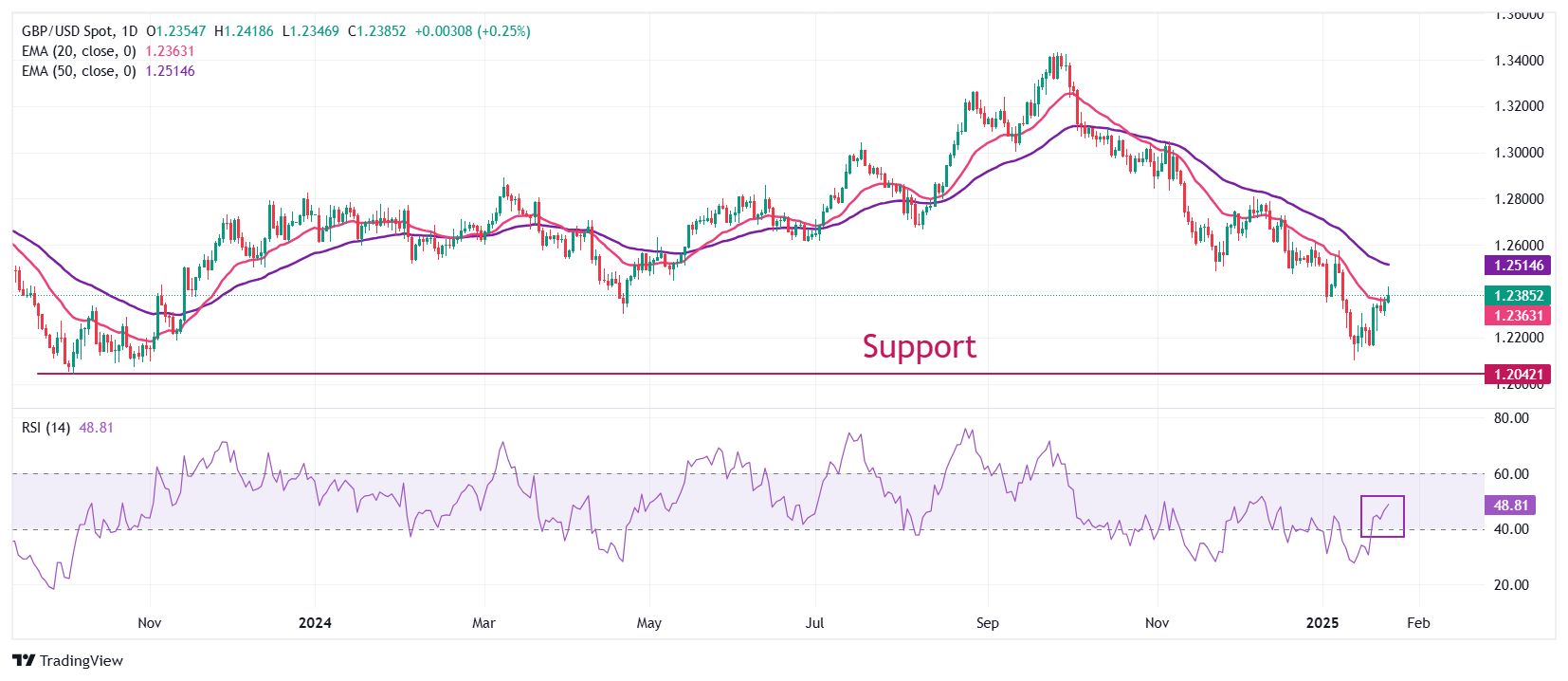Pound Sterling outperforms USD as Trump backs immediate rate cuts
- The Pound Sterling posts a fresh two-week high above 1.2400 against the US Dollar after US President Trump supported immediate interest rate cuts from the Fed.
- The Fed is widely anticipated to keep interest rates steady on Wednesday.
- Flash UK S&P Global PMI data for December remained surprisingly upbeat.
The Pound Sterling (GBP) jumps above 1.2400 against the US Dollar (USD) on Friday. The GBP/USD gains as the US Dollar is onset to end the week with the highest losses in almost two months. The US Dollar Index (DXY), which tracks the Greenback’s value against six major currencies, slumps to near 107.60, the lowest level in over a month after United States (US) President Donald Trump signaled the need for immediate interest rate cuts by the Federal Reserve (Fed) in his commentary at the World Economic Forum (WEF) on Thursday.
"With oil prices going down, I'll demand that interest rates drop immediately, and likewise they should be dropping all over the world," Trump said. His comments have come just a few days before the announcement of the Fed’s first monetary policy meeting on January 29, in which it is certain to announce a pause in the policy-easing cycle and keep interest rates unchanged in the range of 4.25%-4.50%, according to the CME FedWatch tool.
Trump’s call for reducing interest rates immediately is unlikely to impact the Fed, an independent body dedicated to achieving its agenda of maintaining full employment with price stability.
In Friday’s session, the US Dollar will be influenced by the preliminary S&P Global PMI data for January, which will be published at 14:45GMT. The PMI data is expected to show that overall US private business activity remained almost steady in the month.
Daily digest market movers: Pound Sterling gains UK PMI surprisingly expands at faster pace
- The Pound Sterling strengthens against its major peers on Friday as the preliminary United Kingdom (UK) S&P Global/CIPS Purchasing Managers Index (PMI) data for January has come in surprisingly stronger than expected. The agency reported that the Composite PMI expanded at a faster pace to 50.9 from 50.4 in December. Economists expected the PMI to have hardly grown, with the data coming in at 50.0. The robust growth in the Composite PMI came from strong business activity in the services as well as the manufacturing sector.
- Though the overall business activity remains robust in January, analysts at S&P Global showed concerns over weakening labor demand amid falling dales and worries over business prospects.
- Strong PMI numbers are unlikely to diminish market expectations that the Bank of England (BoE) will reduce interest rates by 25 basis points (bps) to 4.5% in February’s monetary policy meeting. These dovish bets are fuelled by soft inflation and employment data and weak household spending.
- On the fiscal front, Chancellor of the Exchequer Rachel Reeves said in an interview with the Wall Street Journal (WSJ) at the sidelines of the World Economic Forum in Davos that she is prepared to announce new measures in a budget update on March 26 to ensure fiscal rules are met Reeves announced in the Autumn budget that the government will rely on foreign financing only for investment.
British Pound PRICE Today
The table below shows the percentage change of British Pound (GBP) against listed major currencies today. British Pound was the strongest against the Japanese Yen.
| USD | EUR | GBP | JPY | CAD | AUD | NZD | CHF | |
|---|---|---|---|---|---|---|---|---|
| USD | -0.51% | -0.49% | 0.19% | -0.33% | -0.34% | -0.47% | -0.10% | |
| EUR | 0.51% | 0.02% | 0.70% | 0.18% | 0.17% | 0.04% | 0.41% | |
| GBP | 0.49% | -0.02% | 0.72% | 0.16% | 0.15% | 0.02% | 0.38% | |
| JPY | -0.19% | -0.70% | -0.72% | -0.54% | -0.55% | -0.68% | -0.31% | |
| CAD | 0.33% | -0.18% | -0.16% | 0.54% | -0.01% | -0.14% | 0.23% | |
| AUD | 0.34% | -0.17% | -0.15% | 0.55% | 0.01% | -0.13% | 0.21% | |
| NZD | 0.47% | -0.04% | -0.02% | 0.68% | 0.14% | 0.13% | 0.36% | |
| CHF | 0.10% | -0.41% | -0.38% | 0.31% | -0.23% | -0.21% | -0.36% |
The heat map shows percentage changes of major currencies against each other. The base currency is picked from the left column, while the quote currency is picked from the top row. For example, if you pick the British Pound from the left column and move along the horizontal line to the US Dollar, the percentage change displayed in the box will represent GBP (base)/USD (quote).
Technical Analysis: Pound Sterling aims to revisist 50-day EMA

The Pound Sterling climbs above 1.2400 against the US Dollar on Friday. The GBP/USD pair gains after breaking above the 20-day Exponential Moving Average (EMA), which trades around 1.2363.
The 14-day Relative Strength Index (RSI) rebounds to near 50.00 from the 20.00-40.00 range, suggesting that the bearish momentum has ended, at least for now.
Looking down, the January 13 low of 1.2100 and the October 2023 low of 1.2050 will act as key support zones. On the upside, the 50-day EMA near 1.2515 will act as key resistance.
Fed FAQs
Monetary policy in the US is shaped by the Federal Reserve (Fed). The Fed has two mandates: to achieve price stability and foster full employment. Its primary tool to achieve these goals is by adjusting interest rates. When prices are rising too quickly and inflation is above the Fed’s 2% target, it raises interest rates, increasing borrowing costs throughout the economy. This results in a stronger US Dollar (USD) as it makes the US a more attractive place for international investors to park their money. When inflation falls below 2% or the Unemployment Rate is too high, the Fed may lower interest rates to encourage borrowing, which weighs on the Greenback.
The Federal Reserve (Fed) holds eight policy meetings a year, where the Federal Open Market Committee (FOMC) assesses economic conditions and makes monetary policy decisions. The FOMC is attended by twelve Fed officials – the seven members of the Board of Governors, the president of the Federal Reserve Bank of New York, and four of the remaining eleven regional Reserve Bank presidents, who serve one-year terms on a rotating basis.
In extreme situations, the Federal Reserve may resort to a policy named Quantitative Easing (QE). QE is the process by which the Fed substantially increases the flow of credit in a stuck financial system. It is a non-standard policy measure used during crises or when inflation is extremely low. It was the Fed’s weapon of choice during the Great Financial Crisis in 2008. It involves the Fed printing more Dollars and using them to buy high grade bonds from financial institutions. QE usually weakens the US Dollar.
Quantitative tightening (QT) is the reverse process of QE, whereby the Federal Reserve stops buying bonds from financial institutions and does not reinvest the principal from the bonds it holds maturing, to purchase new bonds. It is usually positive for the value of the US Dollar.
Forex News
Keep up with the financial markets, know what's happening and what is affecting the markets with our latest market updates. Analyze market movers, trends and build your trading strategies accordingly.
